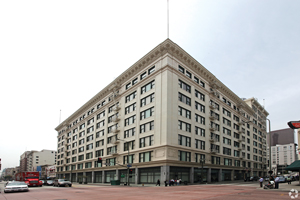After nearly four years, a dispute over a real estate deal gone south for a portfolio of state-owned office buildings worth billions of dollars might soon be resolved.
At issue is a plan that then-Gov. Arnold Schwarzenegger hatched in 2010 to sell and lease back 11 government office complexes, including two in downtown Los Angeles, in an attempt to reduce the state’s ballooning budget deficit.
The deal for the so-called Golden State Portfolio, expected to be worth $2.3 billion, came to a grinding halt in 2011 shortly after Gov. Jerry Brown took office. In a televised press conference, Brown announced the deal was “dead,” saying it didn’t make sense to sell the properties just to turn around and pay rent to keep working in the same offices.
But California First, the buyer selected by the state after a competitive process that yielded nearly 400 offers, didn’t walk away. A consortium of investors led by Houston real estate firm Hines and Irvine private equity group Antarctica Capital Real Estate, California First continued to fight to push the sale through as planned. The frustrated investors say they still want the buildings the state agreed to sell them. They also claim they are entitled to economic damages for lost rents in the intervening years, a sum they have said should be hundreds of millions of dollars.
Now, after failing to reach a settlement, the state and California First will face off in San Francisco County Superior Court. Jury selection will begin Dec. 1, and the trial is estimated to take four to six weeks to complete.
The state’s Department of General Services, which under Schwarzenegger’s administration was authorized to sell the portfolio of government buildings, is expected to argue that the deal fell through not because of any action by the state but because California First missed payment deadlines set out by the purchase agreement.
However, a ruling in a related dispute at the time ordered a stay on the sale two days before the deal was scheduled to close escrow and just one day before full payment was due.
Angela C. Agrusa and Edward A. Klein, attorneys in the Westwood office of L.A. law firm Liner, represent California First in the dispute. Agrusa said her client remains eager to see the deal through to the end.
“It’s been a long time since they filed their action, so they’re pleased to finally have their day in court,” she said.
In an email, Brian Ferguson, deputy director of the Department General Services, call the lawsuit “a misguided effort to resurrect a long-defunct contract.” There was no further comment from the department.
Local properties
The two L.A. properties in dispute as part of the Golden State Portfolio include the Ronald Reagan Building at 300 S. Spring St. and the Junipero Serra State Building at 320 W. Fourth St.
The former, a 740,000-square-foot Class A office property built in 1989, is home to regional offices for the governor, secretary of state, secretary of the senate, attorney general, insurance commissioner and others. The massive 16-story building was valued at about $185 million in the 2010 sale agreement, or about $251 a square foot.
The latter, a 432,000-square-foot Class B office property built in 1914, houses offices for state departments of corporations, corrections, general services, health care services, industrial relations, motor vehicles, public health, real estate and rehabilitation, to name a few. The 10-story beaux-arts building was valued at about $106 million, about $245 a square foot.
Arty Maharajh, vice president of research in the downtown L.A. office of Cassidy Turley, said the buildings, which sit mere blocks from each other, are in areas that have lately seen increased interest from investors.
“Both buildings are in areas that are great for redevelopment – around Broadway, Little Tokyo and the Civic Center – and both are walking distance to the Pershing Square Metro station,” he said. “They both have decent bones, too, especially the Junipero Serra building.”
Such attributes have recently made for big purchase prices for similar buildings nearby. The PacMutual building at 523 W. Sixth St., like Junipero Serra a beaux-arts building constructed in the early 20th century, was recapitalized in the spring in a deal that valued it at $129 million, about $289 a square foot.
Should the deal be forced through by the court, its four-year-old terms could be a big financial blow to the state but a boon to California First. Though $2.3 billion was considered fair market value in 2010, the 7.3 million-square-foot portfolio is likely worth considerably more now for several reasons: With a budget firmly in the black and the pain of layoffs and closures in the past, the state is in better financial shape now than it was four years ago, making it a more attractive and stable tenant; investment capital and debt are more readily available, meaning more buyers are competing in the market; and interest rates remain low, reducing risk and driving capitalization rates down and, as a result, prices up.
In the four years since the deal for the buildings was struck, commercial real estate values in downtown, calculated on a per-square-foot basis, have climbed 34.2 percent on average, according to data from Jones Lang LaSalle Inc.
“In general, all property classes have increased dramatically in value since 2010,” said Bob Safai, a founding partner at Brentwood commercial real estate brokerage Madison Partners who was not involved in the Golden State Portfolio deal. “The debt markets have opened up so the availability of debt is much cheaper today than it was even in 2007, albeit you don’t have the same amount of leverage.”
Cassidy Turley’s Maharajh said the downtown office market is no exception.
“Anyone selling a property pretty much anywhere in downtown is getting premium prices now,” he said. “The market is back up to – and even in some cases surpassing – prerecession highs.”

